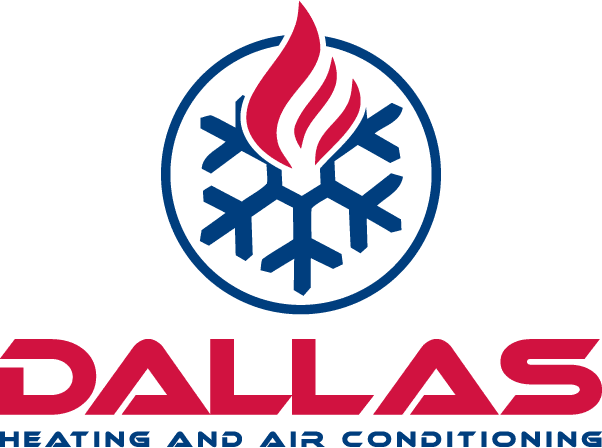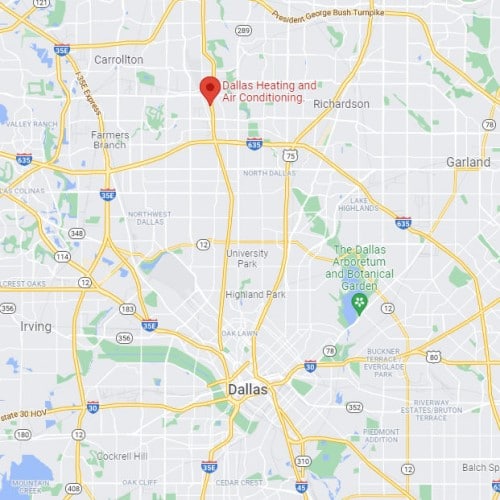Float Switch Location to Meet Texas Building Code

This post is a two part article. Fixing a non-running AC system & explanation of the Texas Building Code (exciting stuff I know!)
We recently received a call from a homeowner that the system had stopped working. The symptoms were:
- The system was blowing cold air prior to them leaving the house to go to work.
- When they got home, the AC wasn't running, and the thermostat was reading 84 degrees. The outside temperature was about 100 degrees. (August in Dallas!!)
- No breakers were tripped, so they turned the HVAC breakers off for a few seconds, then back on, and the system would run again, but only for a few minutes.
The most common causes of this symptom are:
- Dirty or clogged up condenser coil in the outside unit.
- Blown or defective capacitor in the outside unit.
- Dirty air filter in the air return line.
Well, all of those were checked, and everything was good. It's always a good idea to wash out your condenser coils at least once a year, more often if you have lots of pollen producing trees close by. If the system can't "breathe" - i.e. pull or extract air - then the system will shut down to protect the equipment.
We moved on to check the drain lines. In this house, there is a central horizontal air unit in the attic. Underneath the unit is a long metal pan, which can catch condensation coming off of the coils above (more on that later). There are two drains on this unit.
- The primary drain, which takes condensate from the coils and sends it down a tube to the the nearest house plumbing drain - in this case, the pipe goes down and connects to the sink drain of a bathroom.
- The secondary drain is attached to the metal pan that is under the attic unit. This is a section of PVC pipe that connects to a drain hole in the metal pan and slopes across the attic and out through the roof overhang.
Under normal operation, all condensate flows through the primary drain and into the house's sewer lines. If this line gets blocked up, then condensate (water) ends up draining into the pan below the unit, and to the outside of the house.
What Caused the System to Stop Working
What the tech found was that the primary line was totally blocked, so all of the condensate was going into the large pan - per design. However, the secondary drain was also blocked due to a faulty installation.
With both drains not working, a device called a float switch located in the secondary drain went off. As the level of water in the pan got higher, to prevent water overflowing and damaging the house, the float switch triggered, which turned off the AC system. This is all by design, and working as expected.
So the issue here is two-fold:
- Clogged primary drain line.
- Secondary drain not working due to faulty install.
What we Did to Fix the Issue
After cleaning out the primary drain and addressing the secondary drain issue, the AC started running properly again and cooled the home down.
Our tech recommended installing the float device on the primary drain line, which is what he did. The homeowner asked why it was moved and if it was not conforming to code.
Texas Building Code 307.2.3
The question the homeowner had was if the float device was installed in the wrong drain line. Let's look at the Texas Building Code, specifically section 307.2.3. Here's the link if you can't sleep at night and need something dry and boring to read: Link to the Texas Building Code.
The TL;DR version is that you can attach the float switch to either primary or secondary drain lines.
Float Switch in the Primary Drain
Remember that the purpose of a float switch is to prevent water from draining into your home if the drains get clogged up. If you install the float switch into the primary drain, and the primary drain gets clogged up at some point, the system will shut down, even if there's a secondary drain attached to the pan under the HVAC unit.
Float Switch in the Secondary Drain
If the primary drain gets clogged up, condensate (water) will drain into the pan below the HVAC unit and out through the PVC pipe which runs to the outside of the house. If this drain is clogged up - perhaps from bugs, bits of insulation, wood chips from when the roof was last replaced etc, then water will be unable to drain out. If it's unable to drain out, then a float switch in the pan will trigger and cut off the AC.
Either method works and meets the objective. Having a float switch in the primary drain will shut down the system much earlier than it would if we waited for the metal pan to fill up due to a blocked drain.
Note, locate the drain that appears on the exterior of the house. It usually looks like a short piece of round PVC pipe coming out of one of the roof overhangs. If you ever see it dripping, then it means that the primary drain is blocked, and you need to take care of it.
Now for the fun stuff, let's look to see what the Texas Building Code says and convert it into ordinary people speak.
Section 307.2.3 is titled "Auxiliary and Secondary Drain Systems".
In addition to the requirements of Section 307.2.1, where damage to any building components could occur as a result of overflow from the equipment primary condensate removal system, one of the following auxiliary protection methods shall be provided for each cooling coil or fuel-fired appliance that produces condensate:
Translation: you need to have a way to dispose of the water condensate from your HVAC system. And it shall be one of the four options that follows. Ok, that makes sense.
Option 1
An auxiliary drain pan with a separate drain shall be provided under the coils on which condensation will occur. The auxiliary pan drain shall discharge to a conspicuous point of disposal to alert occupants in the event of a stoppage of the primary drain. The pan shall have a minimum depth of 11/2 inches (38 mm), shall be not less than 3 inches (76 mm) larger than the unit, or the coil dimensions in width and length and shall be constructed of corrosion-resistant material. Galvanized sheet steel pans shall have a minimum thickness of not less than 0.0236 inch (0.6010 mm) (No. 24 gage). Nonmetallic pans shall have a minimum thickness of not less than 0.0625 inch (1.6 mm).
Translation: you need to have a drain pan under the HVAC unit which drains to some location where a homeowner can see it's dripping out. Usually this is out through the roof's overhang. The rest of the gobbledygook is about the pan's build & material. We're not interested in that for this discussion. All of our installations include a drain pan under the HVAC unit, as do most other HVAC installers across Texas. No issues here. Note there is no mention of a float switch / water detection device.
Option 3
We skipped option 2 for now to make this article shorter. It's similar to option 1 but talks about units that come with a drain pan from the manufacturer.
An auxiliary drain pan without a separate drain line shall be provided under the coils on which condensate will occur. Such pan shall be equipped with a water-level detection device conforming to UL 508 that will shut off the equipment served prior to overflow of the pan. The auxiliary drain pan shall be constructed in accordance with Item 1 of this section.
Translation: you can have a drain pan under the unit which does not have its own drain line. If this is the case, then you MUST have a water sensing device (the float switch) to detect if there is water in the pan because it hasn't drained out.
Option 4
This talks about the float switch.
A water-level detection device conforming to UL 508 shall be provided that will shut off the equipment served in the event that the primary drain is blocked. The device shall be installed in the primary drain line, the overflow drain line, or in the equipment-supplied drain pan, located at a point higher than the primary drain line connection and below the overflow rim of such pan.
Translation: Install an approved water detection device (float switch) which can shut off the AC system in the event the primary drain gets blocked. It can be installed in EITHER:
- The primary drain line.
- The overflow drain line.
- In the metal pan below the AC unit.
Conclusion
We resolved the dilemma of the homeowner's AC not running by cleaning out the primary drain line and fixing the secondary drain line. While the Texas Building Code gives us the option of where to place the float switch, we prefer to install in the primary drain line to alert us or the homeowner that the primary drain needs to be looked at. It's probably full of crud and nasty stuff that needs to be pushed out of the system anyway.
Opinions of other HVAC professionals
When asked for their opinion, several HVAC professionals gave us their perspective of where they place the float switch:
- "We always put it in the secondary with a float in the pan if one is installed. Never had a problem pass code. Ive also seen float switch put in the main pan above the primary line level."
- "I guess the best bet to protect everyone is a switch in primary, secondary and pan underneath if available. It isn't that costly considering it could save a lot of headaches."
- "On all applications we use the SS1. And when the job has a pan under it we also use a wet switch device. I think mostly it has to do with the inspector. We put a inline SS1 on the condensate drain for the furnace after it tied into the evap coil and it failed. They didn't seem to care if the furnace ran over, the switch had to be at the evap coil. "
- "The main thing is to protect yourself from being sued so if you have to go above what the code is it is worth the extra dollars. Certainly cheaper then the insurance deductible."
- " The IMC also allows you to drain the auxiliary line to a conspicuous point of disposal to alert occupants in the event of a stoppage of the primary drain without having to use a shut off device"
- "I've been putting them in the primary without problem for the last couple of years. Ive never had to put one in the secondary or the pan to get it to pass inspection."
If you enjoyed this article, check out these other articles about air conditioning repair:
Signs that you may need to Repair Your HVAC Unit
How To Hire The Right AC Repair Company


